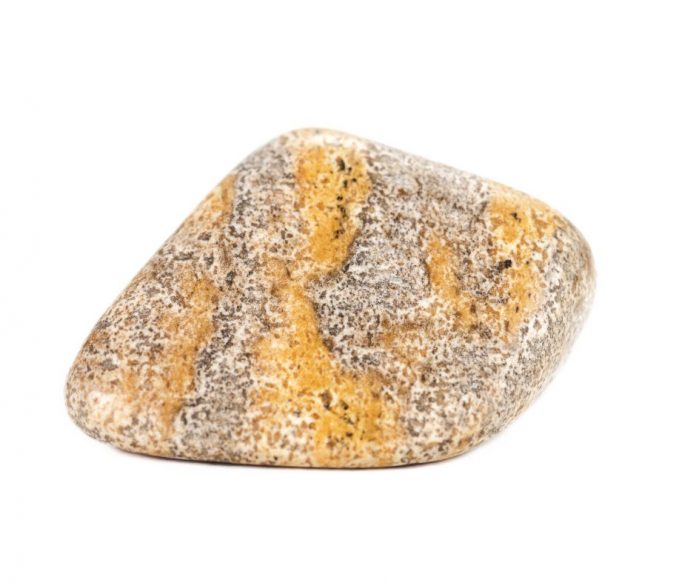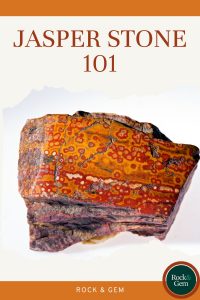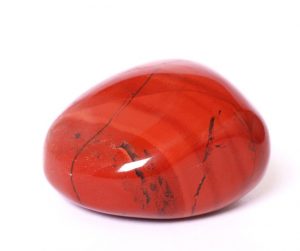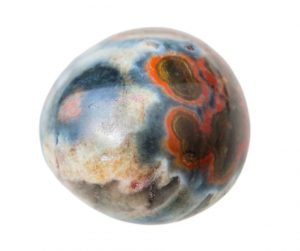
Jasper stone varieties are found all over the world. It is one of the more colorful and varied lapidary stones. It’s also found in a wide range of forms including banded, orbicular brecciated, curving and swirling. Since jasper varieties are found so widely, many are named after the location of discovery.
Jasper Stone Composition
Jasper is basically quartz but its micro-crystals can vary from quartz to chalcedony. The difference is the size and arrangement of the silicon dioxide molecules. In either form, jasper is slightly granular but is almost the hardness of regular quartz so it will develop a good luster when it’s polished.
Because it is rich in microscopic crystals of metallic oxide, mainly iron oxide, these impurities can infiltrate the stone and are dominant in jasper’s lovely colors with reds and yellows being the dominant hues.
Explosive Beginnings
Jasper is found in a variety of environments but is best seen in volcanic areas where it develops in and from volcanic ash deposits. Studies of deposits of colorful jasper indicate that once volcanic ash has been deposited by wind or flowing water it may be reheated by later volcanic activity. Given enough moisture and heat, the ash may become a clay-like material that is flexible enough to be influenced by ground movements that cause bending and folding of the layered clay.

When well insulated by later hot flows, the ash gradually develops a colloid-like structure that is semi-fluid. This is important because in such conditions impurities will have a long time to develop micro-crystals. As molecules form, they have a natural penchant to attract to each other. This is how mineral crystals get their start. Once a few molecules attach, more molecules join.
Forming a Stone
They can join on all sides because the original molecules are suspended. Crystal growth happens in all directions and from all sides and results in the free form of a small rounded body called a spherulite.
This process happens again and again everywhere within the jasper colloid as spherulites simply form wherever there is enough impurity to provide growth. Such growth is not continuous as outside influences like heat and moisture can speed up or slow the radial growth.
When these spherulites are exposed by the lapidary or are near the surface they have the shape and design of small, round flower-like inclusions. Such attractive shapes are given names like poppy jasper. In deposits of undisturbed layered volcanic ash, the ash takes on a linear form of varying layers of alternating color depending on the impurities that are present. Before such jasper hardens, some ground movement can bend or fracture these layers forming undulating shapes or curving images. Severe cases form brecciated jasper.
Banded Jasper

One of the most historically important and largest deposits of banded jasper occurs in the Mesabi Range of the Upper Midwest where alternating bands of bright red to yellow iron-rich hematite and black magnetite or other iron oxides were deposited. Along with the necessary iron ore that triggered America’s Industrial Revolution, these ancient deposits are also producing amazing slabs of banded jasper-like rock that has been bent and curved in layers with alternating red, yellow and even black and metallic looking hues. These huge slabs are popular as decorative stones and can be sealed and used as tabletops and wall hangings, etc.
The name jasper is derived from the French word ‘jaspre’ which means spotted stone.
The formation of these deposits dates back to one of the earliest times in earth’s history called the Great Oxygen Event that changed Earth’s atmosphere from poisonous clouds of methane, ammonia and carbon dioxide to nitrogen and oxygen.
Varieties of Jasper Stone
Picture Jasper – Years ago during some road work in Oregon, fine linear jasper was found in a place near Biggs Junction. The jasper from here was immediately named Picture jasper since it is not only linear but the multi-colored layers often appear like landscapes, horizons and village scenes. The overall colors tend to be shades of brown to red, but are distinct enough to be very attractive.
Bruneau Jasper – Another jasper locality much better known for decades, Bruneau Canyon has become a major source of superb multi-hued brown jasper which formed in alternating light to dark brown layers of rounded nodules. With careful orientation and lapidary work, a Bruneau nodule will produce a large orbicular layering, bull’s eyes and lovely alternating domed tan to brown cabochons.
Orbicular Jasper Varieties
Among all the jaspers, the more popular type is orbicular jasper. It is certainly the most colorful. When you first see an orbicular jasper, regardless of its source, you have to wonder how such a lovely flower-like pattern forms in what appears to be a solid jasper rock.
Poppy Jasper – One particularly colorful orbicular jasper is poppy jasper from near Morgan Hill, Santa Clara County, California, on the side of El Toro mountain. The orbs are bright red in a shape that resembles a poppy blossom. What is remarkable is the number of orbs in a specimen. They are crowded against each other so much that the entire polished surface seems bright red.

Madagascar Varieties – Initially found in 1999, these are among the more colorful orbicular jaspers. It has a registered name of Ocean jasper because the earlier finds of this lovely jasper were on the northwest beaches of this country. Just about every color appears somewhere in patterns that are varied and always attractive. These jaspers are mined from veins that run through the sedimentary deposits in Madagascar. Mining is done in two localities, Kamby near the shore and further inland at Morovata a few miles away. Mining is done by locals and all the producing areas are claimed and off-limits to collectors.
Useful Jaspers
Massive Jasper – Massive jasper is often a dull monochromatic tan to brown and not particularly useful as a lapidary stone. Ancient tribesmen often used jasper as a hard, sharp weapon stone or for weapon points.
Black Granular Jasper – Few lapidary artists today know of the unusual type of jasper key to determining the purity of gold before modern chemistry appeared. Black granular jasper, called a touchstone, was used to streak a piece of gold to determine its purity by its yellow color. Today we’d refer to such a stone as a streak plate. Ancients knew gold could be adulterated with other metals like copper or silver and the only guide to the purity of a gold specimen was to streak the gold on a jasper touchstone to reveal the true color of the gold and judge its purity.
People who love to be involved in working with various forms of jasper are fortunate there are so many varieties to choose from. Their colors and varied designs and patterns can challenge every lapidary’s creative juices and we all enjoy the results.
A Personal InterestAs a mineral collector of some 80 years, my main interest has always been crystallized specimens with only a modest interest in lapidary specimens. That interest was stimulated a couple of decades ago when my good friend and mineral dealer, Benny Fenn, brought out quantities of banded jasper from a new locality in the mountains of western Mexico. The deposit was found by gold prospectors working high in the Sierra Madre Occidental. The deposit was so remote there were no roads and the jasper had to be brought out on the backs of mules. The effort was worth it as the jasper is beautifully patterned and colorful. |
This story about jasper varieties previously appeared in Rock & Gem magazine. Click here to subscribe. Story by Bob Jones.















